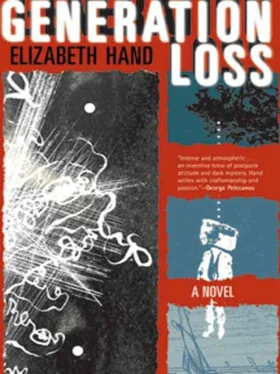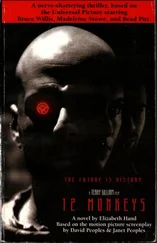“It’s right in there.” He gestured toward the back of the room. “It’s a composting toilet.”
He walked to the front door and stared outside.
The composting toilet reeked of fresh sawdust, shit, spoiled meat, and musk. There was no lock inside the bathroom, no window, no sink. Just a plastic bucket on the floor and a metal shower stall with a heavy canvas curtain.
But there was a second door with shiny new brass hardware. The addition: the new darkroom that Toby had built. I slipped inside and closed the door behind me.
It was pitch black and smelled of sulfur and almonds. I trailed my hand along the wall until I found a switch that bathed the room in red safelight.
Shelves held bottles of pigment, processing chemicals, sheaves of watercolor stock; a five-pound bag of granulated sugar. A table with three sinks was recessed into the wall alongside a plastic water barrel and footpump, a metal garbage can with a lid.
A second table looked as though it had been set for a macabre dinner. Feathers and dead leaves surrounded a single large sheet of paper. Fanned around it were locks of hair arranged by color—black, gray, pale gold—and what appeared to be slivers of dried fungus.
And something else. An oversized scrapbook, its cover made of much-patched and heavily embroidered denim, its title picked out in ransom-note lettering.
EYE
AM
WITHIN
DENNIS AHEARN, S.P.O.T.
Photos spiraled around the title, fragments of snapshots, SX-70 Polaroids, pictures ripped from magazines and newspapers. Every one was an eye.
I touched the raised medallion that surmounted Denny’s name. It was a snapping turtle carapace no bigger than a quarter. Where its head should have been was a minute braid of human hair.
The book was so heavy, I needed both hands to open it. The pages were crowded with Denny’s handwriting and Denny’s photographs, retouched with paint and decorated with dried leaves and flowers, dead insects, feathers, scraps of fur, and human hair, a toenail. There were pictures of a girl with long brown hair, mugging for the camera with a spotted turtle shell in each hand: covering her breasts with the shells, covering her face, laughing. I turned to a Polaroid of Denny and Hannah Meadows, naked and lying side by side, a caption inked beneath in painstaking blue letters.
Sacred and Profane Order of the Turtle
I thought of the awful irony, to play at ritual then have your rites become horribly real, when you discovered your lover’s decomposing body attended by your totems.
When I found her they had been at her already for a week .
I thought of lying facedown on the backseat of a car in the dark; of kneeling in an empty street beneath a broken lamp as another car sped away; of erasing a voice from an answering machine a few hours before the sky filled with ash.
You and me, we carry the dead on our backs.
I stared at the pictures before me, photographs of the dead and collages made of hair and human skin, a fringe of pale eyelashes like a tiny feathered wing, fingerbones and teeth strung on a length of silver cord.
I shivered. Not because I was afraid.
Because it was beautiful. And because I recognized it.
It was like neurons firing inside my own skull, like something I’d dreamed in childhood. I have no idea how long I stood there, turning those pages, but for those moments nothing else mattered. There was only me and a book of photos illustrating rites only I would ever understand, heroes and heroines only I knew. A girl in a white nurse’s uniform, a brave black dog, a schoolbus like a tortoiseshell palace. Lovers dressed in carapaces of bone and dried flesh and hummingbird pelts. A trapdoor had opened in the world and I’d fallen through, onto a bridge built of bone and flayed skin and eyes, the wings of dragonflies and a snapping turtle’s shell. I couldn’t look away.
I turned the final page. A piece of crumpled paper dropped to the floor.
have you seen martin graves?
I closed the book. Music still swirled from the living room. I went to the shelves above the sink, grabbed a packet covered with brown paper and ripped away one corner.
Sheets of plate glass.
I covered my nose then pried open the metal garbage can. It was filled with eggshells and a putrid syrup of rotting yolks. I shoved the lid back in place.
Albumen: egg white. It’s what the earliest photographers used to create a glass negative. It was low-tech, perfect for someone living off the grid. Perfect for someone with time on his hands. You take egg whites and sugar—that’s what the sugar was for—water and potassium iodide, beat them to a froth and decant them. You pour this over a glass plate, then fix it by suspending it above a heat source. A woodstove would be ideal. Afterward you soak each plate in a bath of silver nitrate and gallic acid, rinse off the excess silver, repeat the entire process and let them dry.
I’d read about this stuff, but I’d never known anyone who actually did it. I searched until I found the last part of Denny’s fantasy factory—an unwieldy contraption of black canvas and long wooden poles.
A dark tent. Beside it stood a homemade box camera.
He was making daguerreotypes. The dark tent’s legs—that’s what caused the indentations I’d seen in the ground by the corpse tree. He’d slide the glass negative into the box camera, go outside and set up the tent with its black curtains to keep the light out. He’d shoot.
It would take a long exposure time, a quarter-hour if overcast. That’s why the people in old daguerreotype portraits always have such fixed expressions—they couldn’t move, or the negative would register a blur.
This wasn’t a problem with Denny’s subjects.
And after the neg was exposed…
I looked quickly among the shelves until I found a very old glass prescription bottle.
BOLTON-LIBBY DRUG CO.
BURNT HARBOR, MAINE
I tilted the bottle toward the safelight to read the last word.
MERCURY
Daguerreotypists developed their negs inside the dark tent, holding the glass plate above a bowl of mercury and a spirit lamp. As heated mercury vapor whirled around the plate, the image appeared.
Denny must have done this hundreds of times, for years and years. It’s why his hands shook, and why his gums had turned blue; it explained why everyone said he was such a sweetheart.
He had been, once upon a time. Then Hannah Meadows died, gruesomely, and to memorialize her he revived a lost art, without bothering to learn about its dangers. Otherwise he’d have known that what drove 19th century hatters mad, with brain damage and psychosis, had driven daguerreotypists mad too.
Denny had mercury poisoning.
I put the mercury down and looked until I discovered another century-old bottle, the reason why Denny’s darkroom smelled of bitter almond.
CYANIDE OF POTASSIUM
Daguerreotypists used it to clean glass negs, so they could be reused. I remembered one of my NYU instructors reading a 1856 text on the subject.
I feel a little unwilling to recommend this mode, as it involves the use of the deadly poison cyanide of potassium; but as every man who photographs must necessarily use what we call dangerous chemicals, I can only caution the beginner.
I replaced the bottle, turned off the safelight, and stepped back into the bathroom.
And froze.
The black canvas shower curtain was moving—the slightest ripple, as though from a faint breeze.
But there was no wind, only the wail of music in the next room. I drew the flashlight from my pocket and stepped toward the shower stall; grabbed the curtain and yanked it back.
She lay on her side in five inches of black water, her head above the scummed surface, hair plastered against white skin, her hooded sweatshirt and jeans soaked with filth. Dried blood webbed her cheeks. Her wrists were bound with duct tape, her knees drawn to her chest. There was duct tape across her mouth; duct tape across her eyes, where he had drawn circles in magic marker. A scrawled star was in one of them.
Читать дальше












